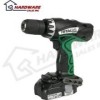Hitachi DV18DCL Handling Instructions - Page 8
Prior To Operation, How To Use - hammer drill
 |
UPC - 717709013025
View all Hitachi DV18DCL manuals
Add to My Manuals
Save this manual to your list of manuals |
Page 8 highlights
Before charging While charging Charging Pilot lamp complete (red) Overheat standby Charging impossible Blinks Lights Blinks Blinks Flickers Table 1 Indications of the pilot lamp Lights for 0.5 seconds. Does not light for 0.5 seconds. (off for 0.5 seconds) Lights continuously Lights for 0.5 seconds. Does not light for 0.5 seconds. (off for 0.5 seconds) Lights for 1 second. Does not light for 0.5 seconds. (off for 0.5 seconds) Battery overheated. Unable to charge. (Charging will commence when battery cools) Lights for 0.1 seconds. Does not light for 0.1 seconds. (off for 0.1 seconds) Malfunction in the battery or the charger (2) Regarding the temperature of the rechargeable battery. The temperatures for rechargeable batteries are as shown in Table 2, and batteries that have become hot should be cooled for a while before being recharged. Table 2 Recharging ranges of batteries Rechargeable batteries Temperatures at which the battery can be recharged BCL1415, BCL1815 0°C - 50°C (3) Regarding recharging time Depending on the combination of the charger and batteries, the charging time will become as shown in Table 3. Table 3 Charging time (At 20°C) Battery Charger UC18YKL BCL1415, BCL1815 Approx. 60 min. NOTE The charging time may vary according to temperature and power source voltage. 4. Disconnect the charger's power cord from the receptacle 5. Hold the charger firmly and pull out the battery NOTE After charging, pull out batteries from the charger first, and then keep the batteries properly. How to make the batteries perform longer. (1) Recharge the batteries before they become completely exhausted. When you feel that the power of the tool becomes weaker, stop using the tool and recharge its battery. If you continue to use the tool and exhaust the electric current, the battery may be damaged and its life will become shorter. (2) Avoid recharging at high temperatures. A rechargeable battery will be hot immediately after use. If such a battery is recharged immediately after use, its internal chemical substance will deteriorate, and the battery life will be shortened. Leave the battery and recharge it after it has cooled for a while. CAUTION ○ When the battery charger has been continuously used, the battery charger will be heated, thus constituting the cause of the failures. Once the charging has been completed, give 15 minutes rest until the next charging. ○ If the battery is recharged when it is warm due to battery use or exposure to sunlight, the pilot lamp blinks. The battery will not be recharged. In such a case, let the battery cool before charging. ○ When the pilot lamp flickers (at 0.2-second intervals), check for and take out any foreign objects in the charger's battery installation hole. If there are no foreign objects, it is probable that the battery or charger is malfunctioning. Take it to Hitachi Authorized Service Centers. PRIOR TO OPERATION 1. Setting up and checking the work environment Check if the work environment is suitable by following the precautions. HOW TO USE 1. Confirm the clutch dial position (See Fig. 4) The three modes of screwdriver, drill and hammer drill can be switched by the position of the cap in this unit. (1) When using this unit as a screwdriver, line up the one of the numbers "1, 3, 5 ... 22" on the clutch dial, or the dots, with the triangle mark on the outer body. (2) When using this unit as a drill, align the clutch dial drill mark " " with the triangle mark on the outer body. (3) When using this unit as an hammer drill, align the cap hammer mark " " with the triangle mark on the outer body. CAUTION ○ The clutch dial cannot be set between the numerals "1, 3, 5 ... 22" or the dots. ○ Do not use with the clutch dial numeral between "22" and the line at the middle of the drill mark. Doing so may cause damage (See Fig. 5). 2. Tightening torque adjustment (1) Tightening torque Tightening torque should correspond in its intensity to the screw diameter. When too strong torque is used, the screw head may be broken or be injured. Be sure to adjust the clutch dial position according to the screw diameter. 8















